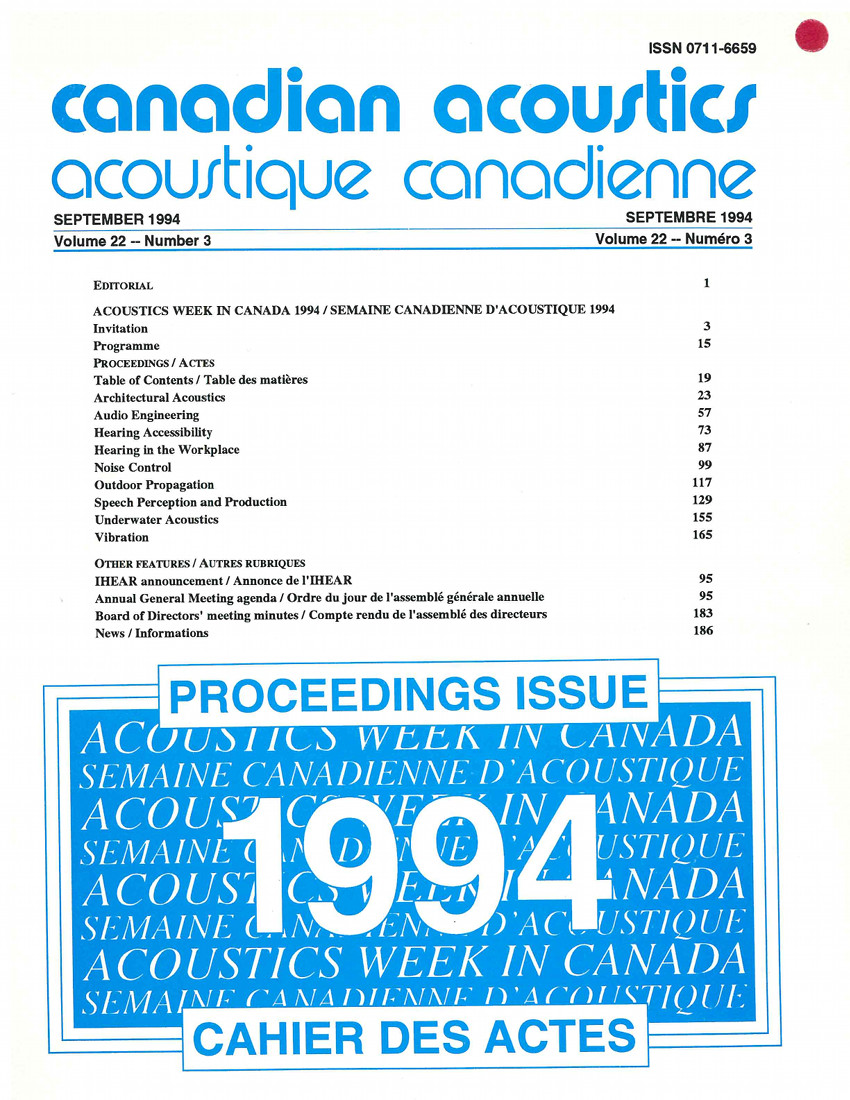Shear membranes in wood frame party walls
Keywords:
architectural acoustics, structural acoustics, wood, wood frame party walls, fibreglass batt insulation, gypsum wall board, plywood faces, resilient channel, plywood membrane, fibreglass filled stud cavity, 80 to 250 HzAbstract
On a recent project, Brown Strachan had recommended a standard party wall construction consisting of 2×6 wood studs @ 16" o.c., separated by a 1" air space, with fibreglass batt insulation in the stud cavities, and one layer of 5/8" gypsum wall board (gwb) on each outside face. This wall has a typical sound transmission class rating of STC 57. Late in the design stage, however, the structural consultant added a requirement for 1/2" plywood on both inside faces of some walls. The plate spacing was increased to maintain a 1" clear space between the two inside plywood faces. A Gypsum Association test shows STC 57 with 1/2" Type X gwb on the inside face of studs @ 24" o.c. On the basis of this test, the architects concluded that the change was acceptable, as the Code required a STC 50 rating. Geiger & Hamme had tested a similar wall consisting of 5/8" drywall on the inside of studs spaced 16" o.c., and obtained a rating of STC 45. Obviously, the bending stiffness of the inside face had a major effect on the net stiffness of the air trapped between the two inside layers, spaced 1" apart. Plywood is about eight times as stiff as gwb, and since the stiffness of the inside plate is the key factor in determining the stiffness of the air, a problem was clearly indicated. Potential treatment options included resilient channel, extra layers of drywall, and holes in the plywood membrane which would act to vent air in the 1" airspace to the fibreglass filled stud cavity. A mathematical model was used to study the effects of the various treatment options, and field measurements were made to determine the treatment resultsAdditional Files
Published
How to Cite
Issue
Section
License
Author Licensing Addendum
This Licensing Addendum ("Addendum") is entered into between the undersigned Author(s) and Canadian Acoustics journal published by the Canadian Acoustical Association (hereinafter referred to as the "Publisher"). The Author(s) and the Publisher agree as follows:
-
Retained Rights: The Author(s) retain(s) the following rights:
- The right to reproduce, distribute, and publicly display the Work on the Author's personal website or the website of the Author's institution.
- The right to use the Work in the Author's teaching activities and presentations.
- The right to include the Work in a compilation for the Author's personal use, not for sale.
-
Grant of License: The Author(s) grant(s) to the Publisher a worldwide exclusive license to publish, reproduce, distribute, and display the Work in Canadian Acoustics and any other formats and media deemed appropriate by the Publisher.
-
Attribution: The Publisher agrees to include proper attribution to the Author(s) in all publications and reproductions of the Work.
-
No Conflict: This Addendum is intended to be in harmony with, and not in conflict with, the terms and conditions of the original agreement entered into between the Author(s) and the Publisher.
-
Copyright Clause: Copyright on articles is held by the Author(s). The corresponding Author has the right to grant on behalf of all Authors and does grant on behalf of all Authors, a worldwide exclusive license to the Publisher and its licensees in perpetuity, in all forms, formats, and media (whether known now or created in the future), including but not limited to the rights to publish, reproduce, distribute, display, store, translate, create adaptations, reprints, include within collections, and create summaries, extracts, and/or abstracts of the Contribution.


